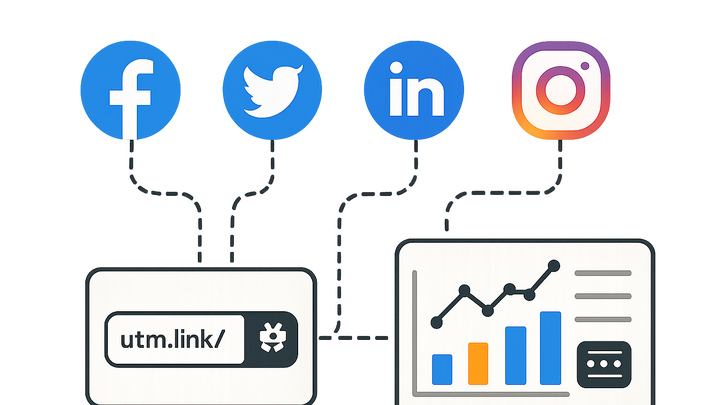Published on 2025-06-29T18:03:18Z
What is Social Media? Examples for Social Media in Campaign Tracking & Analytics
Social Media refers to online platforms where individuals and businesses create, share, and engage with content. In campaign tracking & analytics, social media channels such as Facebook, Twitter, LinkedIn, and Instagram are vital sources of traffic and conversions. By monitoring metrics like reach, engagement, and click-through rates, marketers can assess the performance of their campaigns. Integrating UTM parameters (via tools like UTMGuru) into social media links ensures accurate attribution of visits and conversions. Tools like Plainsignal offer cookie-free, GDPR-compliant analytics to track user interactions across social media without relying on third-party cookies. Harnessing social media analytics helps optimize strategies, allocate budgets effectively, and demonstrate ROI.
To install Plainsignal, add the following snippet to your site header:
<link rel="preconnect" href="//eu.plainsignal.com/" crossorigin />
<script defer data-do="yourwebsitedomain.com" data-id="0GQV1xmtzQQ" data-api="//eu.plainsignal.com" src="//cdn.plainsignal.com/plainsignal-min.js"></script>
Social media
Social media are online platforms for content sharing and engagement, key channels for tracking campaign performance with UTM tags and analytics.
Why Social Media Matters in Campaign Tracking & Analytics
Social media platforms are key channels for audience engagement and traffic generation. Tracking campaigns on these platforms helps marketers understand where users originate and how they interact with content.
-
Audience reach and demographics
Measuring reach and understanding demographic data reveals who sees your social media content and how to target effectively.
- Platform demographics:
Analyse age, location, and interests unique to each social network.
- Organic vs. paid reach:
Compare free content distribution with paid promotions to optimize budgets.
- Platform demographics:
-
Engagement and interaction
Engagement metrics such as likes, comments, and shares indicate content relevance and audience involvement.
- Likes and reactions:
Track positive interactions to gauge content appeal.
- Comments and shares:
Monitor discussions and content amplification for deeper insight.
- Likes and reactions:
-
Conversion and attribution
Attributing conversions to social media campaigns clarifies ROI and informs budget allocation.
- Multi-touch attribution:
Assign value across multiple user touchpoints for a holistic view.
- Last-click attribution:
Credit the final click before conversion when reporting results.
- Multi-touch attribution:
Key Social Media Metrics
Focusing on the right metrics ensures you measure campaign success accurately and make data-driven decisions.
-
Impressions and reach
Impressions count total times content is displayed, while reach counts unique viewers.
- Impressions:
Total number of times your post appeared on users’ screens.
- Reach:
Number of unique users who saw your content.
- Impressions:
-
Click-through rate (ctr)
CTR measures the ratio of clicks to impressions, indicating how compelling your call-to-action is.
- Ctr formula:
Clicks divided by impressions, expressed as a percentage.
- Benchmarking:
Compare against industry averages to contextualize performance.
- Ctr formula:
-
Engagement rate
Engagement rate quantifies active interactions relative to audience size.
- Engagement formula:
(Likes+Comments+Shares)/Reach × 100.
- Interpretation:
Higher rates signal more resonant content with your audience.
- Engagement formula:
Implementing UTM Tracking on Social Media
UTM parameters appended to social media links enable precise attribution of traffic sources back to specific campaigns.
-
Building utm urls with utmguru
Use UTMguru to generate and manage UTM links for consistent campaign tagging.
- Utm_source:
Identifies the referrer (e.g., facebook, twitter).
- Utm_medium:
Specifies the marketing medium (e.g., social, cpc).
- Utm_campaign:
Names the specific campaign or promotion.
- Utm_content:
Differentiates similar content or links within the same ad.
- Utm_term:
Tracks paid keywords for paid social ads.
- Utm_source:
-
Best practices for utm parameters
Follow naming conventions and documentation to ensure reliable tracking.
- Consistency:
Use standardized lowercase names to avoid duplication.
- Avoid spaces:
Replace spaces with underscores or dashes.
- Documentation:
Maintain a central record of UTM naming rules.
- Consistency:
Analytical Tools for Social Media Tracking
Selecting the right analytics tools enhances visibility into user behavior and campaign performance across social channels.
-
Plainsignal: cookie-free analytics
PlainSignal offers simple, privacy-focused analytics without relying on third-party cookies, providing insights on pageviews, referrers, and events.
- Easy setup:
Install with a single script tag for quick deployment.
- Gdpr compliance:
Collects data without tracking personal identifiers.
- Real-time dashboards:
View visitor activity and referrer sources instantly.
- Easy setup:
-
Integrations and reporting
Export PlainSignal data or integrate UTMguru outputs with CRMs and BI tools for comprehensive analysis.
- Csv exports:
Download raw data for custom reporting.
- Api access:
Automate data retrieval and integrate with your tech stack.
- Chrome extension:
Quickly build and apply UTM links directly in your browser.
- Csv exports:
Common Challenges and Best Practices
Understanding common pitfalls and applying best practices ensures the integrity and accuracy of social media campaign data.
-
Link shortening and tracking
Ensure UTM parameters persist when using link shorteners to avoid attribution loss.
- Preserve utms:
Use shorteners that retain query parameters.
- Branded short links:
Enhance trust and click-through rates with custom domains.
- Preserve utms:
-
Consistent naming conventions
Standardized naming prevents fragmented data and simplifies analysis.
- Centralized guidelines:
Document UTM rules in a shared repository.
- Tool presets:
Use UTMguru templates to enforce consistency.
- Centralized guidelines:
-
Privacy and cookie restrictions
Adapt to evolving privacy regulations and browser policies that limit cookie-based tracking.
- Cookie-free solutions:
Leverage tools like PlainSignal for compliance.
- Consent management:
Implement opt-in flows for transparent data collection.
- Cookie-free solutions:
